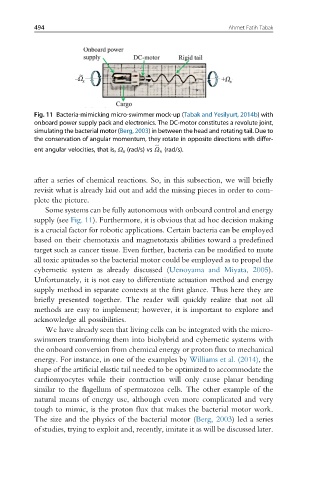Page 500 - Handbook of Biomechatronics
P. 500
494 Ahmet Fatih Tabak
Fig. 11 Bacteria-mimicking micro-swimmer mock-up (Tabak and Yesilyurt, 2014b) with
onboard power supply pack and electronics. The DC-motor constitutes a revolute joint,
simulating the bacterial motor (Berg, 2003) in between the head and rotating tail. Due to
the conservation of angular momentum, they rotate in opposite directions with differ-
ent angular velocities, that is, Ω x (rad/s) vs Ω x (rad/s).
after a series of chemical reactions. So, in this subsection, we will briefly
revisit what is already laid out and add the missing pieces in order to com-
plete the picture.
Some systems can be fully autonomous with onboard control and energy
supply (see Fig. 11). Furthermore, it is obvious that ad hoc decision making
is a crucial factor for robotic applications. Certain bacteria can be employed
based on their chemotaxis and magnetotaxis abilities toward a predefined
target such as cancer tissue. Even further, bacteria can be modified to mute
all toxic aptitudes so the bacterial motor could be employed as to propel the
cybernetic system as already discussed (Uenoyama and Miyata, 2005).
Unfortunately, it is not easy to differentiate actuation method and energy
supply method in separate contexts at the first glance. Thus here they are
briefly presented together. The reader will quickly realize that not all
methods are easy to implement; however, it is important to explore and
acknowledge all possibilities.
We have already seen that living cells can be integrated with the micro-
swimmers transforming them into biohybrid and cybernetic systems with
the onboard conversion from chemical energy or proton flux to mechanical
energy. For instance, in one of the examples by Williams et al. (2014), the
shape of the artificial elastic tail needed to be optimized to accommodate the
cardiomyocytes while their contraction will only cause planar bending
similar to the flagellum of spermatozoa cells. The other example of the
natural means of energy use, although even more complicated and very
tough to mimic, is the proton flux that makes the bacterial motor work.
The size and the physics of the bacterial motor (Berg, 2003) led a series
of studies, trying to exploit and, recently, imitate it as will be discussed later.

